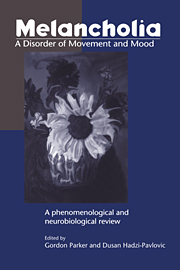Book contents
- Frontmatter
- Contents
- List of contributors
- Acknowledgments
- Introduction
- Part One Classification and Research: Historical and Theoretical Aspects
- Part Two Development and Validation of a Measure of Psychomotor Retardation as a Marker of Melancholia
- Part Three The Neurobiology of Melancholia
- 15 Melancholia as a Neurological Disorder
- 16 Melancholia and the Ageing Brain
- 17 Magnetic Resonance Imaging in Primary and Secondary Depression
- 18 Functional Neuroimaging in Affective Disorders
- 19 Summary and Conclusions
- The CORE Measure: Procedural Recommendations and Rating Guidelines
- References
- Author Index
- Subject Index
18 - Functional Neuroimaging in Affective Disorders
from Part Three - The Neurobiology of Melancholia
Published online by Cambridge University Press: 04 August 2010
- Frontmatter
- Contents
- List of contributors
- Acknowledgments
- Introduction
- Part One Classification and Research: Historical and Theoretical Aspects
- Part Two Development and Validation of a Measure of Psychomotor Retardation as a Marker of Melancholia
- Part Three The Neurobiology of Melancholia
- 15 Melancholia as a Neurological Disorder
- 16 Melancholia and the Ageing Brain
- 17 Magnetic Resonance Imaging in Primary and Secondary Depression
- 18 Functional Neuroimaging in Affective Disorders
- 19 Summary and Conclusions
- The CORE Measure: Procedural Recommendations and Rating Guidelines
- References
- Author Index
- Subject Index
Summary
Introduction
Melancholic depression is by nature an episodic disorder, with imputed transient and/or fluctuating abnormalities in neurotransmission (Ferrier and Perry 1992). Given the hypothesis (Austin and Mitchell 1995; Krishnan 1993b; and Chapter 15) that dysfunction in frontal-subcortical neural pathways contributes to the pathogenesis of melancholia, the use of functional imaging, which allows us to capture the physiological changes present at the time of scanning, is ideal for the study of such a recurrent clinical condition. Neuroimaging strategies can be divided into those providing information on structure (e.g., CT and magnetic resonance imaging [MRI]) or on function (e.g., positron emission tomography [PET] and single photon emission computed tomography [SPECT]). The introduction of functional imaging techniques such as PET and SPECT to quantify changes in regional cerebral blood flow (rCBF) and metabolism thus holds the potential to elucidate the neuroanatomical substrate specific to melancholic (vs. non-melancholic) depression and may even eventually aid in the diagnostic process.
PET and SPECT Techniques. PET allows assessment of regional cerebral metabolism, and therefore regional cerebral function. In contrast to PET, SPECT measures rCBF, relying on the premise that under normal conditions, rCBF is tightly yoked to regional metabolism. Whereas SPECT measures the emission of single gamma rays or photons from the radiotracer, PET measures the simultaneous emission of two gamma rays (produced by the reaction of an electron and a positron) and thus enables “absolute” quantitation of gamma ray counts to take place.
Information
- Type
- Chapter
- Information
- Melancholia: A Disorder of Movement and MoodA Phenomenological and Neurobiological Review, pp. 267 - 276Publisher: Cambridge University PressPrint publication year: 1996
